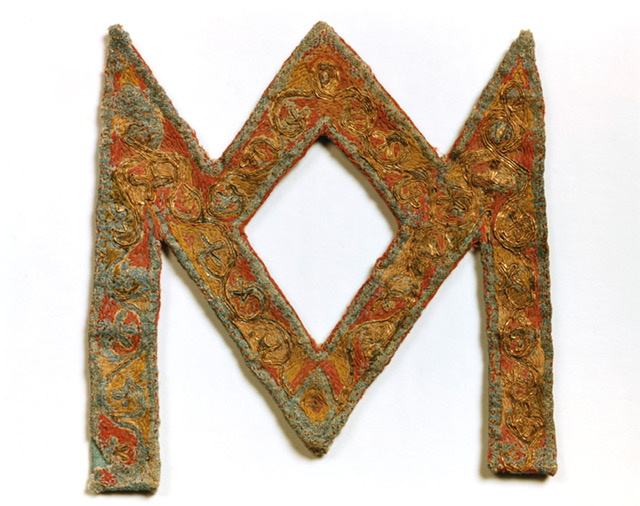For nearly two years we have been meaning to go, and then longing to go, and finally yesterday we were allowed to go, to the small town of Maaseik in northeastern Belgium, close to the border with the Netherlands. Why all this interest in a small Belgian town?
Maaseik is home to a group of Anglo-Saxon embroideries associated with the Frankish Saints Harlindis and Relindis. The two saints lived in a Benedictine establishment at the nearby village of Aldeneik, which was set up by their parents around AD 730.
 The so-called Casula of Saints Harlindis and Relindis, before conservation and separation of the constituent parts. Early medieval. Photograph courtesy of the Musea Maaseik.
The so-called Casula of Saints Harlindis and Relindis, before conservation and separation of the constituent parts. Early medieval. Photograph courtesy of the Musea Maaseik.
The Maaseik embroideries are more widely know as the Casula (chasuble) of the two sisters, both of whom died in c. 750. The vestment associated with the two saints consisted of a large panel that is made up of a mosaic (patchwork) of different textiles and embroideries. These are regarded as being some of the oldest, extant religious embroideries in northern Europe.
Apparently in 1571 the Casula was taken from the Aldeneik church to the nearby Sint-Catharina church in Maaseik, where it was kept together with other early medieval textiles, such as the so-called Davidzijde (‘David silk’), the velamen of Harlindis, and a stola-like weave that may date to the ninth century (or before). All of these pieces are now in the church's Treasury.
The Casula itself included eight different embroideries and appears to originate from three different garments or objects. The pieces were sewn together in the form of a patchwork. The constituent parts have recently been separated for conservation.
 One of the monograms that formed part of the Casula of Saints Harlindis and Relindis. Early medieval. Courtesy Musea Maaseik.The different embroideries of the Maaseik Casula can be divided as follows:
One of the monograms that formed part of the Casula of Saints Harlindis and Relindis. Early medieval. Courtesy Musea Maaseik.The different embroideries of the Maaseik Casula can be divided as follows:
- Group A consists of two embroidered bands (incomplete) with a series of arches or arcades with foliage and animals.
- Group B are two strips with a series of roundels enclosing animals.
- Group C consists of four monograms that appear to have been made separately with the intention of sewing them onto another textile. They seem to represent an M and an A or an M and an O.
Most of the embroidery was carried out in the form of gold thread embroidery using surface couching, while the background was in split stitch, using silk in various colours. It has been suggested that pearls had originally been attached to the embroideries, but at some point these had been removed.
Some scholars believe that the embroideries were produced in England, as the designs are in the Anglo-Saxon style, with their use of intricate knotwork, floral and animal motifs, strong architectural features (the arcades) and the use of roundels to enclose motifs.
 Detail of an embroidered group of men and women on a long band, late medieval. Courtesy Musea Maaseik.The Sint-Catharina Church also has a small number of late medieval embroidered bands (lambrekijn), perhaps part(s) of an altar front, with some beautifully embroidered figures of three men and three women (perhaps the donors?), as well as some vestments decorated with bands of earlier embroidery.
Detail of an embroidered group of men and women on a long band, late medieval. Courtesy Musea Maaseik.The Sint-Catharina Church also has a small number of late medieval embroidered bands (lambrekijn), perhaps part(s) of an altar front, with some beautifully embroidered figures of three men and three women (perhaps the donors?), as well as some vestments decorated with bands of earlier embroidery.
Should you decide to go and see the embroideries, then you need to book tickets via the Musea Maaseik. We would like to express our thanks to them for arranging our visit and allowing us to take a number of photographs.
We would also recommend staying at the Agnetenklooster B&B. The Agnetenklooster was a medieval foundation and one of the largest in the neighbourhood. It was closed down by the French in 1797 and sold two years later. It has been a private home ever since and has now become a B&B. The church is a few minutes' walk from the B&B.
See also the TRC Needles entry for the Maaseik embroideries, click here.
Gillian Vogelsang, 26 June 2021










